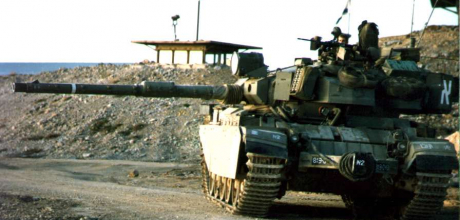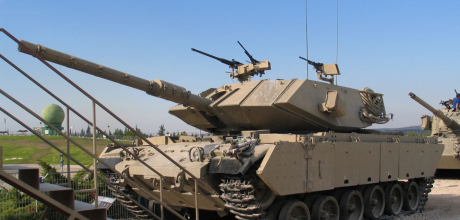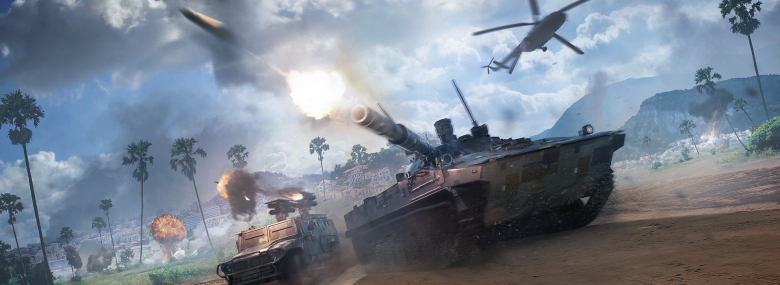
Commanders!
Today, we are introducing the first vehicle of the Israeli Main Battle Tank branch – the Tier 1 M50, commonly (if incorrectly) known under the name “Super Sherman”. But to talk about the M50, we first have to mention the M4 Sherman tank.

M50
The iconic M4 Sherman was the best American tank of the Second World War and probably the best tank of the war in general. It’s not that it was amazing in any particular aspect – it didn’t have the biggest gun, it wasn’t the fastest nor did it have outrageously thick armor. It was, simply put, an excellent mix of all the properties a good tank needs – firepower, armor, mobility, reliability and crew comfort. Used by both the United States of America and the Soviet Union (as a part of the Lend-Lease program), it outperformed the vast majority of Nazi tanks every step of the way and had proven itself as a reliable workhorse of the Allied tank forces.
The wartime exploits of this tank are, however, beyond the scope of this article and are best left to such excellent publications as R. P. Hunnicutt’s History of the American Medium Tank. Suffice to say that almost 50 thousand Shermans of all types were built over the course of the war and, by the time the shooting ended, great many of them were given away or sold to numerous nations across the world. Post-war Sherman models are generally described in our previous article but let us focus for now on how they found their way to Israel.
Of course, by 1945, there was no Israel – not yet. There was only an idea of a refuge for the Jewish people from the Holocaust horrors. Israel would only be born three years later, tempered in the fires of battle in no small part due to the disastrous post-war British foreign policies. Regardless of the circumstances, the Jewish people found themselves once again in war and ever war needs weapons – including tanks.
When the Arab armies invaded in 1948 to squash the nascent Jewish entity, they were, in many cases, armed with wartime British and American weapons left in Northern Africa after the surrender of the German Afrikakorps. The Jews – generally very lightly armed and suffering from the lack of modern weaponry – scrambled and managed to put together a number of salvaged vehicles, including the first Israeli Shermans.
The history of the very early Shermans is described in another dedicated article – some were saved (without their weapons) from an Italian scrap and later retrofitted with cannons (ironically German ones made by Krupp), others were salvaged from wrecks left by the British in Palestine. By the end of the Israeli War of Independence, the newly born Israeli Armored Corps boasted 32 combat-ready Shermans, mostly old wartime models. These 75mm-armed variants received the Israeli designation M3 as opposed to the 76mm variants (purchased after the Independence War) that received the designation M1 (based on the name of its gun) and a nickname that would make them famous – “Super Sherman”.
Both the 75mm M3s and the M1s served in the victorious 1956 Sinai war, ironically fighting against the Egyptian Shermans, but it soon became clear that the next time the Israelis would fight the Arabs, they would be facing late-war Soviet armor instead of worn-out British and American surplus vehicles, which is why they reached out to the French for help with upgrading their tanks to something that could take on the Arab T-34s and live to see the day.
But why the French? After all, today it’s the United States of America that is regarded as Israel’s staunchest ally and the Shermans were American tanks. The answer to this question lies in the politics of the era.
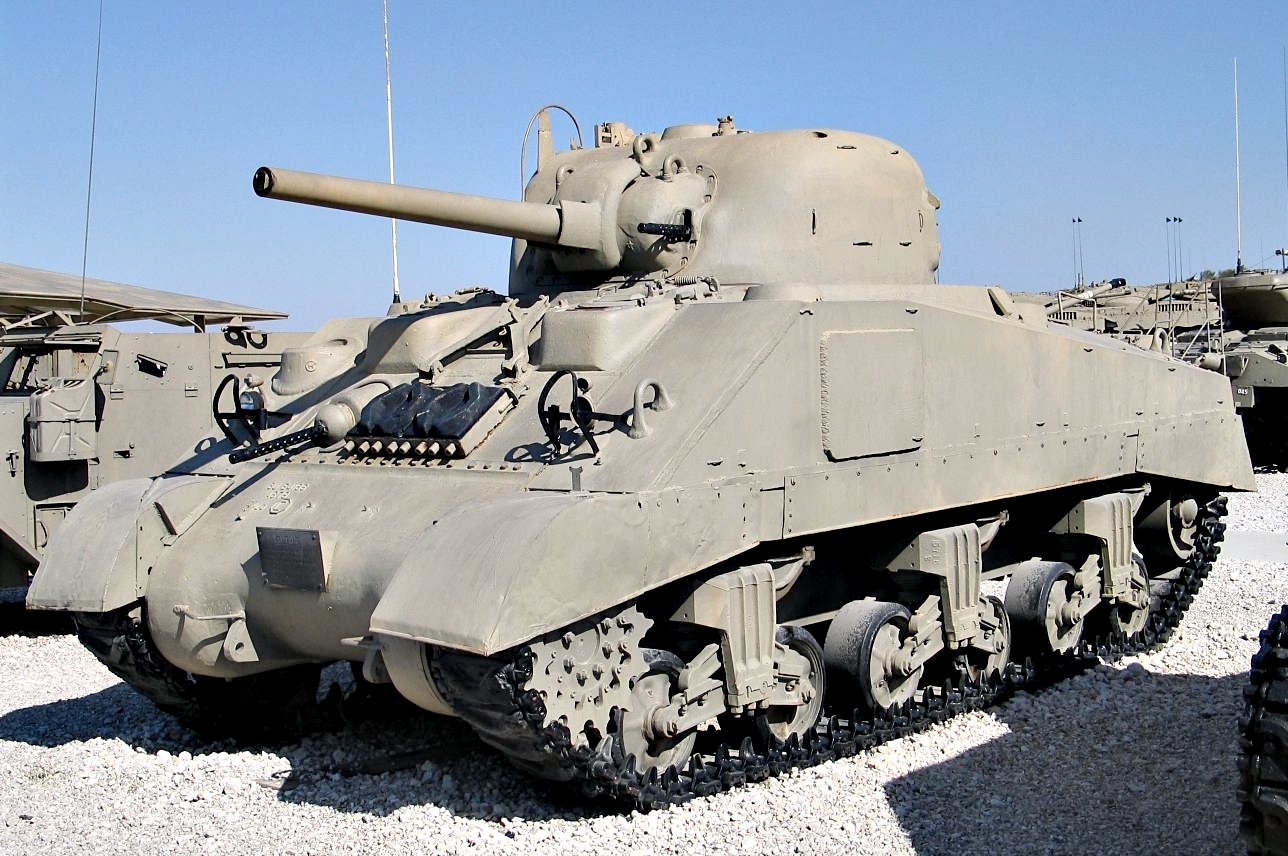
Israeli M4A4 Sherman in the Latrun museum
By the time the 1948 war began, the relations between Britain and the Jewish community were, to put it mildly, strained. The complicated events that preceded the war left Britain mostly on the side of the Arabs with the British military in the region, bitter after several years of anti-British attacks, going as far as to ensure that the bases they were leaving during their retreat from the area would fall into Palestinian hands. The position of the United States was also quite complicated in the matter – Britain was their wartime ally and a large portion of the American administration, including President Harry Truman, were quite tired of the American Jewish diaspora’s unrelenting pressure.
In the end, much of the vital help (without which the Jews would have lost) came from France and Czechoslovakia (with Soviet approval). For the Soviets, the whole aid thing was basically an opportunity to gain a foothold in the region at the expense of the British. For France and Czechoslovakia, the matter was, aside from a certain degree of pragmatism, also emotional to a degree with France enamored with the romantic idea of the Jewish struggle for freedom. It was also a good opportunity to poke their eternal rival, Britain – plus, it’s not like the weapons sold or given to the Jews were cutting edge technology. They were mostly captured German or obsolete pre-war weapons.
And so it was that, in one of the greatest ironical twists of modern age, Czechoslovak-refitted Messerschmitts thundered above the Sinai desert, only this time piloted by Jewish volunteers instead of German pilots, while men below them fought with German Kar98k rifles against the British-equipped Arabs. History does at times have a sense of humor.
Naturally, things changed after the war with the relations between Israel and the Soviet Union (and therefore also with the countries in its sphere of influence) deteriorating all the while the relationships with Britain and France improved. This, too, would change eventually, but that was the situation in the 1950s. The shift in the Soviet position, on the other hand, represented a serious threat to Israel. The Soviets – or, specifically, the Czechoslovaks on their behalf – started to supply the Arab countries (Egypt, Syria, Iraq) with large amounts of post-war T-34s. These weren’t the early 76mm model T-34s though – these were the late 85mm gun variants license-produced in Czechoslovakia with a number of improvements, outclassing the 75mm and 105mm Shermans completely. The only tanks that were capable of fighting them on equal terms were the M1 “Super Shermans” (Shermans armed with the 76mm M1A1 or the 76mm M1A2 guns) and even the M1s didn’t have much of an advantage save for the renowned bravery of their crews.
Another threat was the SD-100 (Czechoslovak license-produced SU-100), a powerful self-propelled gun capable of knocking out any tank in Israeli arsenal at considerable distance. In short, the Israelis really needed an upgrade.
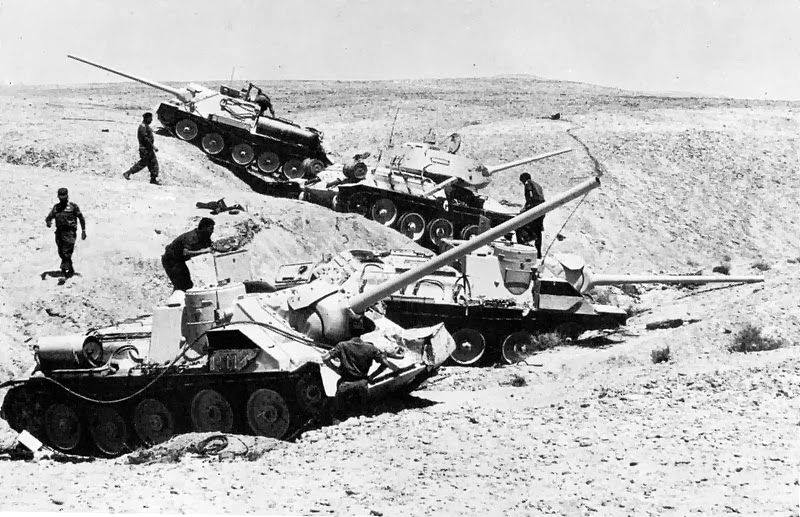
SD-100s captured by Israel
In 1955, Israeli engineers and the Bourges Arsenal in France began working together on a future tank for the Israeli Armored Corps. The Israelis had rather simple demands – the tank had to be relatively affordable, available in large numbers fast enough and relatively easy to train on. It is therefore no wonder that the French went for a platform that was both familiar to the Israelis and available in large numbers – the Sherman.
The core of the upgrade was the replacement of the main weapon with the French CN-75-50, the very same gun used on the AMX-13 Light Tank, only without an automatic loading mechanism the Israelis didn’t like very much (that was why Israel never purchased the AMX-13 although a certain number of them was captured later on).
The gun was of French origin, but it was in its core a development of the German 75mm KwK 42 – the famous German Panther gun. It was initially installed in a modified M4A2 turret (the basic 75mm model) but this, naturally, caused space issues (the gun was fairly large). The turret therefore had to be made longer by welding steel plates to the front of it, resulting in a fairly distinctive look.
To balance the turret in order to compensate for the additional frontal weight, the rear of the turret was prolonged as well by welding a heavy hollow bustle to it that was used to house a radio. This extension was mounted on the remains of the original turret bustle that was cut away – this went for pretty much all the turret models that were used in the conversion, including those with the dry stowage and wet stowage bustle types. This upgraded model then received an Israeli designation of M50 (based on its gun designation).
The Egyptians (at that point mortal enemies of Israel) too reached out to the French regarding an upgrade of their own Shermans at the same time. The Egyptian approach was different – they had the FL-10 oscillating turrets installed on their Sherman hulls, resulting in an interesting hybrid. Ironically, the Egyptian Shermans and the Israeli Shermans, both built by the same company, fought each other on more than one occasion and several of the Egyptian Shermans were captured.

Egyptian M4A4 Sherman with a FL-10 turret
All sorts of Shermans – pretty much all the sub-types the Israelis got their hands on – were converted this way to the M50 standard, resulting in a wide variety of sub-types. The basic sub-types used as the basis for the M50 upgrades included:
- M4A1 (75mm variant, cast hull)
- M4A4 (75mm variant, welded hull)
- M4A3 (75mm variant, welded hull)
The truth is that nobody really knows how many Shermans of which types were used in these conversions and the sources differ on that account. Even the M50s had a lot of different details (welded hulls, cast hulls, different types of basic turrets) so there isn’t basically just “one” M50 – it’s a whole family of vehicles sharing roughly the same characteristics. Let’s take a look at some of those using the early production M4A1 with an M34 turret (75mm M3 gun) as a basis.
The M50 weighed approximately 34 tons (2 tons more than a standard M4A1) and had a crew of five men. Some sources claim that the crew was reduced to four men based on the fact some of these vehicles had their hull machinegun ports welded shut, but this was not true – at least not intentionally, it’s possible that some M50s operated with four men only due to manpower shortages.
The hull and turret were a classic World War Two concept, with a hull machinegunner and everything. The armor was, of course, steel (in this case, cast steel hull) of the following thicknesses:
- Upper frontal plate: 51mm
- Lower frontal plate: 51mm
- Sides: 38mm
- Rear: 38mm
- Roof: 19mm
- Bottom: 25mm to 13mm
- Turret mantlet: 76mm
- Turret front: 76mm
- Turret sides and rear: 63mm
- Turret roof: 19mm
It’s worth noting that the armor was improved on later models – the M4A3 had as much as over 90mm of effective frontal armor (2.5 inches at 47 degrees from vertical), rivaling the German Tiger in protection at a fraction of cost! However, by mid-1950s, it was not enough to protect the vehicle from Soviet 85mm and 100mm weapons (let alone anything heavier). The vehicle had at least two French smoke grenade launchers installed to provide it with some cover.
The tank was powered – at least in this sub-variant – by a 400hp (gross horsepower, that is) Continental R975 C1 radial engine. Radial engines were neither the best solution overall, nor the most reliable one, but, in combination with a 5-gear manual gearbox, it allowed the tank to go perhaps 35-40 km/h – it wasn’t exactly the fastest tank on the battlefield. Other M50 models used:
- Continental R975 C4 radial engine (460hp)
- General Motors 6046 (410hp)
- Ford GAA (500hp)
- Chrysler A57 Multibank engine (425hp)
It’s worth noting that the maximum speed did not change regardless of each engine’s horsepower.
And then, of course, there was the gun – the French CN-75-50, developed from the famous Panther gun. It was quite long (62 calibers in length) and produced an excellent muzzle velocity (for its time) of 1000 m/s. The Model 1951 French armor-piercing ammunition was capable of defeating 110mm of armor (or 60mm at 60 degrees). The gun was manually loaded and had an effective rate of fire of some 10 rounds per minute.
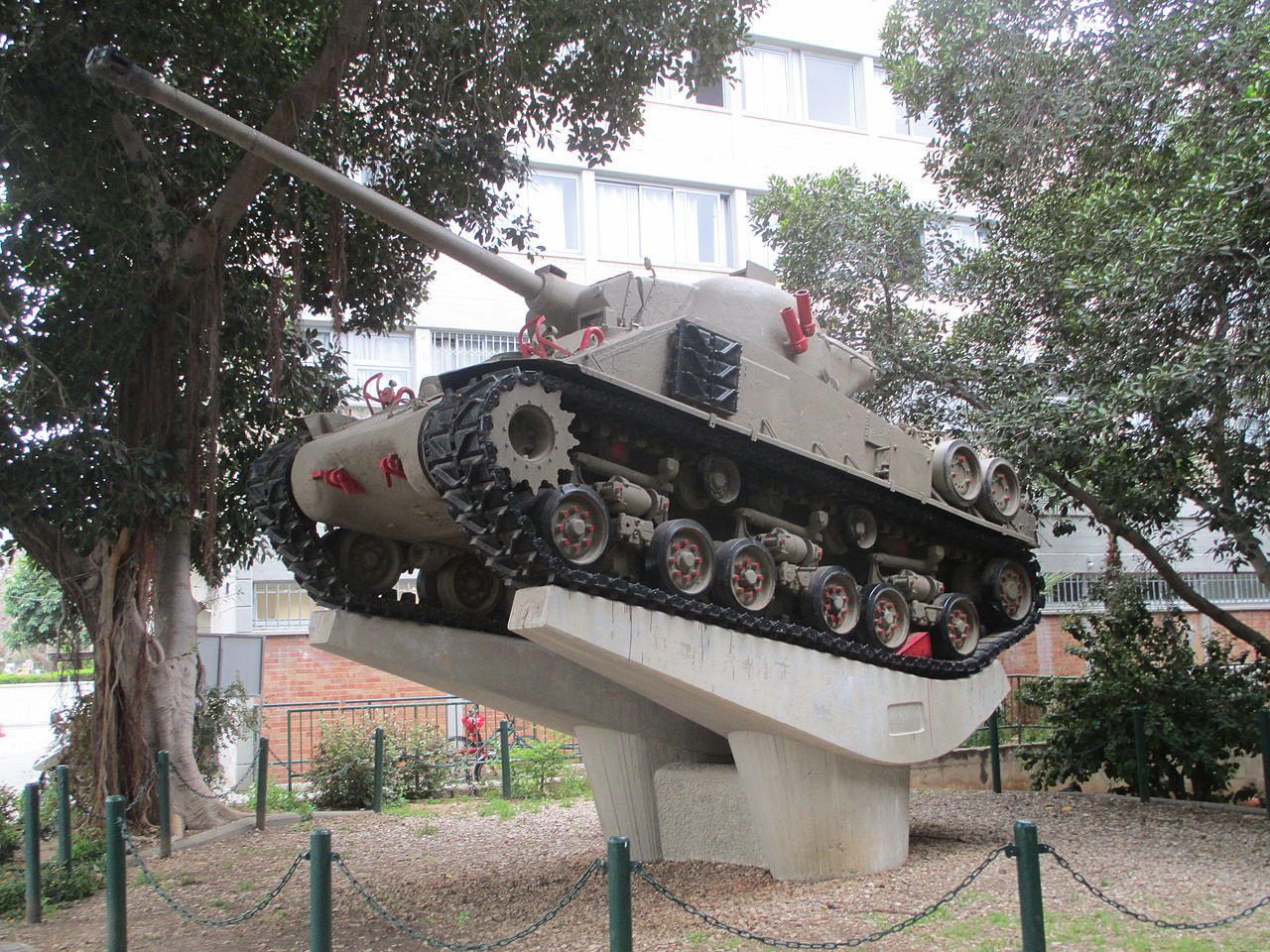
M50 in Tel Aviv
The first conversions happened directly in France while one turret was sent to Israel to serve as a prototype for the assembly planned there. Only a relatively small number of M50s were ready and shipped to Israel before the beginning of the 1956 Suez crisis – roughly enough to equip an armored company. Most of these were based on the M4A4 and the M4A1 sub-types but from that point onwards, sources vary on the exact composition of the M50 Shermans.
The production of the M50s in Israel itself took a long time. The first vehicles converted in Israel were delivered in late 1956, but by April 1959, only 50 tanks were completed with 50 more tanks delivered until June 1961. Speaking of 1960s – around that time, the original tank engines of the tanks were completely worn out, which is why, starting from the early 1960 or so, they were generally replaced by a 460hp Cummins VT8-460 diesel. The M50s with the new engines can be recognized by a different engine deck and are sometimes referred to as “Mark 2” M50s (making the 1956-1960 M50 “Mark 1”). By 1965, however, all M50s received:
- Cummins VT8-460 engine
- HVSS suspension
And were thus converted to the Mark 2 standard. It’s worth noting that the Mark 1 tanks are also sometimes referred to as “Continental” M50s while the Mark 2 tanks are referred to as “Cummins” M50s.
In battle, the M50s performed reasonably well against late World War Two era threats such as the T-34s, but with the appearance of new threats such as the American-supplied Pattons and the Soviet T-54/55 tanks, even the upgraded M50s became completely outclassed with the preferred Israeli tactic (sniping at vulnerable spots using superior gun performance and rigorous training) no longer being applicable and forcing them to fight enemies at close range, suffering high losses in the process. Regardless, the M50s took part in both the 1956 Suez Crisis and the 1967 Six-Day War.
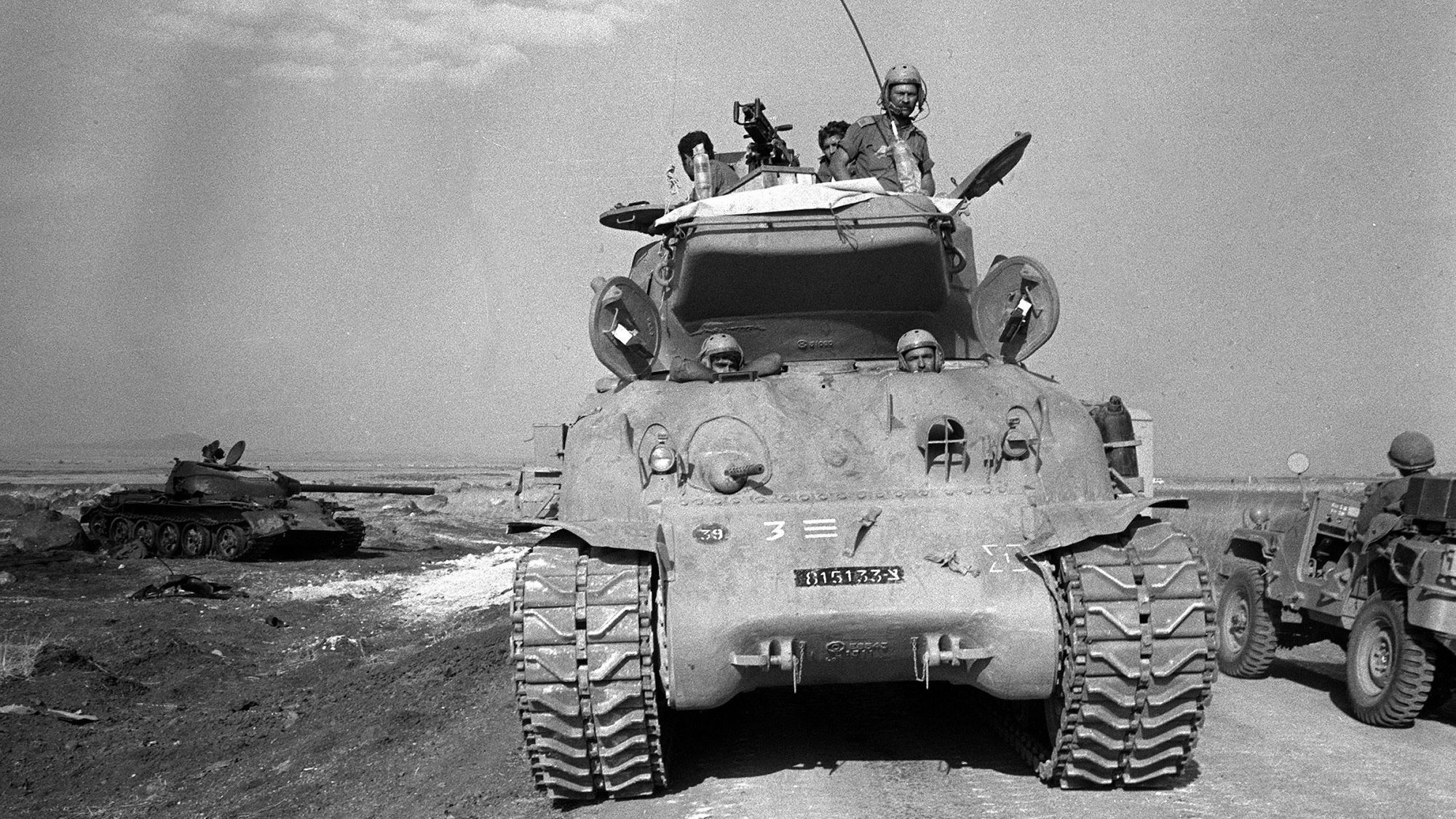
Upgraded Sherman in the 1973 Yom Kippur war
Some were still in service with several reserve units during the 1973 Yom Kippur War, but by that time, they were hopelessly obsolete They were withdrawn from active service after the war and some of them were converted to fixed emplacements (effectively hollowed out tank hulls with functional turrets). A bunch of M50s were given to the South Lebanon Army and some militias during the mid-1970s Lebanese Civil War, from where a lot of them were sold to private collectors. And, last but not least, around a hundred were sold to Chile.
In Armored Warfare, the M50 will be a Tier 1 Main Battle Tank, marking the return of the class to the very beginning of the game. Mobility-wise, it will be inferior to the Light Tanks currently available on Tier 1, but it will be the most armored vehicle of the Tier with considerable firepower offered by its 75mm cannon. Much like its real life counterpart, the vehicle will feature a progression from its original engine to the Cummins diesel and will excel in fighting at longer distances. It’s time to practice your sniping skills!
We hope that you will enjoy it and will see you on the battlefield!




